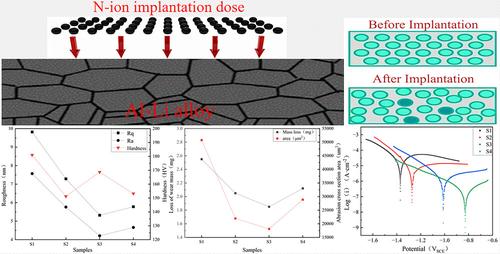氮离子注入可显著提高铝锂合金的摩擦学性能和耐蚀性
IF 4.8
3区 综合性期刊
Q1 MULTIDISCIPLINARY SCIENCES
引用次数: 0
摘要
铝锂合金因其良好的性能而受到广泛关注;然而,它们的耐磨性和耐腐蚀性仍需进一步提高。在我们的研究中,氮离子以30 keV的能级注入2195铝锂合金。采用x射线衍射、原子力显微镜、扫描电镜和摩擦学测试仪器对样品的微观结构特征和力学性能进行了系统的研究。结果表明,离子注入对材料表面产生软化作用。然而,它显著提高了合金的耐磨性和耐腐蚀性。随着注入剂量的增加,摩擦系数呈现先减小后增大的趋势;当注入剂量达到5 × 1015离子/cm2时,耐磨性能达到最佳。此外,随着注入剂量的增加,材料的耐蚀性呈比例提高。与未处理的基材相比,注入样品的腐蚀电流密度降低了两个数量级,腐蚀速率降低了62%。结果表明,高剂量氮离子注入是提高2195铝锂合金耐磨损和耐腐蚀性能的有效途径。本文章由计算机程序翻译,如有差异,请以英文原文为准。

Nitrogen ion implantation significantly enhances the tribological properties and corrosion resistance of aluminum–lithium alloy
The study of aluminum–lithium alloys has garnered significant attention due to their promising properties; however, further enhancement of their wear and corrosion resistance is still required. In our study here, nitrogen ions were implanted into 2195 aluminum–lithium alloy at an energy level of 30 keV. The microstructural characteristics and mechanical properties of the samples were systematically investigated using X-ray diffraction, atomic force microscopy, scanning electron microscopy, and a tribological testing apparatus. The data showed that ion implantation induces a softening effect on the material surface. Nevertheless, it significantly improves both wear and corrosion resistance of the alloy. As the implantation dose increased, the friction coefficient exhibited a trend of first decreasing and then increasing; optimal wear performance was achieved when the implantation dose reached 5 × 1015 ions/cm2. Additionally, the corrosion resistance improved proportionally with the increase in implantation dose. Compared to untreated base material, the corrosion current density of the implanted samples decreased by two orders of magnitude, and the corrosion rate reduced by 62%. These results demonstrate that high-dose nitrogen ion implantation is an effective approach for enhancing the wear and corrosion resistance of 2195 aluminum–lithium alloys.
求助全文
通过发布文献求助,成功后即可免费获取论文全文。
去求助
来源期刊

Annals of the New York Academy of Sciences
综合性期刊-综合性期刊
CiteScore
11.00
自引率
1.90%
发文量
193
审稿时长
2-4 weeks
期刊介绍:
Published on behalf of the New York Academy of Sciences, Annals of the New York Academy of Sciences provides multidisciplinary perspectives on research of current scientific interest with far-reaching implications for the wider scientific community and society at large. Each special issue assembles the best thinking of key contributors to a field of investigation at a time when emerging developments offer the promise of new insight. Individually themed, Annals special issues stimulate new ways to think about science by providing a neutral forum for discourse—within and across many institutions and fields.
 求助内容:
求助内容: 应助结果提醒方式:
应助结果提醒方式:


